- 1Faculty of Land and Food Systems, The University of British Columbia, Vancouver, BC, Canada
- 2Department of Population Medicine, Ontario Veterinary College, University of Guelph, Guelph, ON, Canada
While uncontrolled outdoor access can increase opportunities for cat physical and mental stimulation, it can also increase risks of injury and illness, and result in predation of wild birds and small animals. In Canada and the United States, it is often recommended to keep cats indoors, but many owners still provide some level of outdoor access. The objectives of this study were to use a cross-sectional survey to explore the attitudes and practices of cat owners in Canada and the United States toward outdoor access and to identify factors that influence the provision of uncontrolled outdoor access. A convenience sample of cat owners (N = 7,838) were recruited to complete an online survey, and a mixed logistic regression model was used to examine associations between cat and owner-related factors, and uncontrolled outdoor access for cats, with province/state included as a random effect. In total, 57% of owners kept their cats indoors, and 43% provided some form of outdoor access, with 21% of total owners providing uncontrolled outdoor access. Provision of uncontrolled outdoor access was associated with factors related to cat characteristics (e.g., sex, breed, presence of health, and behavioral issues), the home environment (e.g., living with other pets, types of enrichment provided), owner perspectives on outdoor access (e.g., level of agreement with potential benefits and consequence of outdoor access), and owner demographics (e.g., gender, education, area of residence). For cats with uncontrolled outdoor access, few owners reported their cats having a collar or a microchip, suggesting a need to increase education about precautionary measures to protect the welfare of outdoor cats. Results reveal how owners are caring for their cats in terms of providing outdoor access and generate hypotheses for future research to examine the influence of the owner-pet bond and educational programs on owner practices around providing outdoor access.
Introduction
It has been reported that 37% of Canadian households and 35% of American households own one or more cats (1, 2), which translates to ~9.3 million companion cats living within households in Canada (1) and 95.6 million in the United States (2). In recent years, both humane societies and wildlife organizations have developed educational campaigns to discourage cat owners from allowing uncontrolled outdoor access (i.e., free-roaming and unsupervised) due to the associated risks to both cats (3, 4) and wildlife (5, 6). Despite these educational campaigns, many cats are still allowed unrestricted outdoor access, without supervision. Based on a report from 2017, Canadian estimates suggest that 56% of owned domestic cats are housed indoors, 16% have outdoor access controlled (e.g., via direct supervision, enclosed area, and kept on a harness), and 28% are allowed at least some level of uncontrolled outdoor access (1).
It has been suggested that outdoor access has welfare benefits for cats since it promotes physical activity and natural behaviors (7), such as hunting, exploring, and climbing, and allows cats some level of autonomy to interact with their environment. Since cats were domesticated primarily for pest control, they remain highly motivated to perform predatory behaviors, including hunting and chasing (8), and have displayed preferences for climbing and perching on higher ground (7). Owned cats in England have also been reported to travel an average of 4.4 kilometers a day (9) when allowed outdoors. Indoor housing has been criticized as providing insufficient opportunities to meet these described needs. Cats confined to homes with limited space or opportunities for exercise are more likely to develop obesity, and other associated health issues (e.g., cardiorespiratory and urogenital disorders) (10). The inability to perform natural behaviors indoors has also been suggested to lead to frustration or boredom, resulting in the development of problematic behaviors (e.g., aggression, furniture scratching, or inappropriate elimination). Studies involving owner-completed surveys have found that some behavior problems are more prevalent in indoor cats than cats with outdoor access (11–14). However, another study found that behavior problems in indoor-restricted cats can be reduced through provision of some forms of enrichment (15).
In contrast, it has also been suggested that outdoor access has the potential to negatively impact cat health and welfare, as it exposes them to increased risks. For instance, cats that are allowed outdoors are at an increased risk of contracting diseases (e.g., feline immunodeficiency virus, rabies, and feline leukemia virus) or parasites through interaction with and exposure to other cats, and to wild or feral animals (8). Outdoor cats also have an increased risk of injury, predation, and poisoning. In areas with heavy traffic, particularly in urban cities, cats are at a higher risk of being involved in vehicle collisions which can cause serious injuries and acute or chronic health issues (7). Predation on cats by predators, such as dogs and coyotes, can also result in trauma and death of cats. Dog bites alone were reported to cause 10% (3/31) of cat trauma fatalities in a study at the Western College of Veterinary Medicine (16). Toxic hazards prevalent in neighborhood gardens or public parks, such as pesticide runoff, water contamination, and certain plants (e.g., lilies) can also increase risks of renal damage, vomiting, or death for outdoor cats (17).
Free-roaming cats can also negatively affect people and other animals. While freely roaming the outdoors, cats can be a nuisance to humans through excessive vocalization or inappropriate elimination on neighbors' properties (18, 19). They can also impact other animals through predation, with one study estimating that cat predation in the United States causes between 6.3 and 22.3 billion mammal deaths and between 1.3 and 4 billion bird deaths per year (20). While these numbers are staggering, most of this predation was attributed to unowned cats, with only 11% being attributed to owned, roaming cats. Further some have suggested these figures might be an overestimation of actual predation levels, and that there is little evidence of population-level impacts in terms of biodiversity as a result of cat predation (21). Regardless of debate over the overall impact of predation by owned cats, it is clear that outdoor access can, at a minimum, contribute to negative effects of cats on welfare and individual survival of wild species (22). Further, if owned cats do not return home they can contribute to unowned (stray or feral) cat population issues, and in turn, related predation. In 2016, Canadian shelters received an estimated 114,131 cats where 56% were admitted as strays and only 10% of these strays were returned to their owners (1).
Limited research has explored factors that influence owner decisions about provision of outdoor access in Canada and the US. In 2001, Clancy et al. (23) released a survey to 184 cat owners to assess owner attitudes toward outdoor access for cats in the US and found that 40% of cats had some degree of outdoor access; however, the authors did not differentiate between controlled and uncontrolled access. They found cats acquired from shelters were less likely to have outdoor access than cats acquired as strays, which they hypothesized was due to increased educational efforts from humane societies. They concluded that owners' decisions to provide outdoor access is multifactorial, suggesting a further study involving a broader population was necessary. In another large-scale study that was international in scope, significant regional differences were noted in attitudes and practices around provision of outdoor access, with owners in the UK, Europe, New Zealand, and Australia being more likely to provide uncontrolled outdoor access than owners in Canada and the US (24). Owners in this study that kept their cats indoors cited several reasons for indoor restriction including concerns about road traffic, protection from other people, animals or wildlife, protection of wildlife from predation, the cat getting lost, and factors related to the individual cat being unable to cope outdoors due to health or temperament. In contrast, reasons that were cited for allowing cats indoor-outdoor access included factors such as improving the cat's mental and physical health, pest control, having a multi-cat household, and the cat having had previous outdoor access.
While research in North America is limited, a number of studies from Australia and New Zealand have examined attitudes and practices of owners around cat containment. Recent figures from this region suggest that a majority of cat owners are allowing cats outdoors, with only 30 and 53% of study participants reporting containment at all times (25, 26). Studies from these regions have examined factors that influence intentions and actions around containment and highlighted various relevant factors. One study found that a majority of owners were concerned about cat safety and protection of native wildlife, with only half of participants being concerned about reducing unwanted breeding and preventing nuisance behavior (25). Further, support for containment at night in cat owners was related to stronger beliefs about impacts on wildlife and cat safety, and beliefs about containment predicted practices around containment. Other studies have also found that owner support for containment is associated with perceived benefits to that cat (26–28) and benefits to the owner (27), and some studies have also found that owner confidence around containment (28) and their perceived control is important (26). However, the influence of concerns about impacts on wildlife has been variable. While Toukhsati et al. (25) found that beliefs about wildlife were important to cat owners, other studies have found either no relationship or only a weak correlation (26, 27) between concerns about wildlife and containment perspectives. One recent study examined interventional messages about wildlife concerns and found that they were effective at increasing motivation to contain and belief that owners could contain (29), so it is possible that these differences between studies reflect a lack of understanding of the potential impact of cats on wildlife.
The overall objective of the current study was to better understand the attitudes and practices of Canadian and American cat owners toward provision of outdoor access through an online cross-sectional survey targeted to current cat owners. A number of specific factors relating to the cat, owner, and home environment have been hypothesized, based on previous literature as described above, to contribute to decisions about providing outdoor access, so a specific objective was to identity factors associated with the provision of uncontrolled outdoor access using regression modeling.
Methods
This project was reviewed and approved by the University of Guelph (#18-08-019) and The University of British Columbia Research Ethics Boards (#H18-02597) for research involving human participants. A detailed electronic information letter was provided to participants at the landing page for the survey, and consent was demonstrated by participants submitting the survey responses following completion.
Data Collection
Current cat owners completed an online cross-sectional survey that included questions about practices around provision of outdoor access, details of the home environment, and cat and owner demographic information. Inclusion criteria for participants required individuals be 18 years of age or older, a primary caregiver of at least one cat (e.g., routine financial and care responsibilities), and a current resident of either Canada or the United States of America. We used convenience sampling that involved recruitment via snowball sampling on social media, with the initial advertisement shared through Facebook and Twitter. This recruitment method relies on referrals from participants, as participants are encouraged to share the survey to recruit other persons who fit the specific criteria. Thus, from our initial posts, participants were asked to share the social media advertisement with their contacts. This sampling technique has been shown to efficiently reach targeted groups that are otherwise challenging to access (30, 31). The survey was advertised and available from October 31 to November 19, 2018.
Questionnaire
The survey was created using Qualtrics® and was available online. The questionnaire was developed from current literature on topics related to acquisition sources (23), behavioral issues (32), outdoor access (8), and enrichment (15). The questionnaire was comprised of 43 questions categorized into four sections: cat characteristics (e.g., sex, age, breed, source, neuter status, health, and behavioral issues); home environment (e.g., living with other pets, type of outdoor access provided, enrichment techniques used); owner perspectives on outdoor access (e.g., level of agreement with potential benefits and consequences of outdoor access); and owner demographics (e.g., gender, education, age). Specific details about outdoor access were determined by asking yes-no closed-ended questions as to whether owners provide free-roaming unsupervised access, directly supervised access, enclosed outdoor access (e.g., catio), or access on a leash, harness or tie out. If participants owned more than one cat, they were instructed to respond to the survey for only one cat within the household. Selection bias was limited by asking them to respond based on the cat whose name begins with the letter closest to the beginning of the alphabet. In addition, participant responses were not connected to any directly or indirectly identifying information to minimize potential social desirability bias.
Statistical Analysis
All analyses were performed with Stata Statistical Software v.15.1 (StataCorp, College Station, TX, USA).
Data Management
The initial dataset included 107 variables. During data cleaning, questions that had “other” as an option were cross-referenced with existing options to ensure answers were not misrepresented, thereby reducing misclassification bias. For ease of analysis, related variables were collapsed to create the following overarching variables: medical issues (e.g., gastrointestinal issues, skin conditions), aggression (e.g., toward people, cats), ownership of other non-cat pets (e.g., dogs, birds), and interactive enrichment (e.g., small toys, food devices).
Logistic Regression Model
A mixed logistic regression model was developed to test associations between independent variables and the dependent variable, owner-reported provision of uncontrolled outdoor access. Country and province/state were included as random effects. Referent categories for categorical variables were chosen based on biological plausibility or based on the most common response. Correlation analysis was performed on all retained variables, with a correlation coefficient of >|0.7| suggesting collinearity (33). Five correlations related to owner perspectives of outdoor access were detected during this assessment (perspective of access providing natural hunting behavior, natural environment, risk of obesity, natural exploratory behavior, and physical activity), and the most biologically meaningful variables that captured the most information were retained for further analysis (natural hunting behavior, natural environment, and physical activity) (33). Linear relationships between continuous independent variables and the outcome variable (uncontrolled outdoor access) were visually assessed using locally weighted regression curves (lowess) and quadratic relationships were assessed by testing the significance of a quadratic term. If the relationship was quadratic, the quadratic term was retained in the model. If the relationship was neither non-linear nor quadratic, the continuous variable was categorized. As a result of non-linear associations, the following variables were categorized based on biological/practical cut-points: participant age (18–24, 25–44, 45–64, 65+), time spent playing with the cats per day (<1, 1, 2, 3–12 h), and the number of cats owned (1, 2, 3+). Also, cat age was categorized based on the cat life stages presented in the AAFP 2010 guidelines (<4 months, 4–12 months, 1–6 years, 7–10 years, 11–14 years, and >15 years) (34).
Univariable analysis was performed to test each independent variable against the outcome, uncontrolled outdoor access. Variables were retained using a liberal p-value of p ≤ 0.20 (35). The final main effects model was built using forward stepwise selection method, where significant variables (p < 0.05) were retained in the final model. Two-way interactions between biologically plausible variables were tested. Confounders were tested based on their biological plausible relationship with an explanatory variable and the outcome. They were identified as a variable that caused >20% change in a coefficient of another variable in the model. Standardized Pearson residuals were used to detect outliers. The fit of the model was determined by assessing the homoscedasticity and normality of the best linear unbiased predictions (BLUPS). Also, the intra-class correlation coefficients (ICC) were estimated to measure the degree of correlation between cats owned within the same country and province/state.
Results
Descriptive Data
A total of 7,977 responses were collected from the survey and 7,838 complete responses were retained for analysis. The majority of participants resided in Canada (84.5% with 67% of participants residing in Ontario) and 15.5% of participants resided in the United States. Participants were 91.1% women, 5.9% men, and 3% who preferred not to disclose their gender identity or reported their identity was not listed. Participants had a mean age (SD) of 41.6 (13.8) years (range: 18–100+ years) and their corresponding owned cats had a mean age (SD) of 2.2 (1.9) years old (range: <4 months−20+ years). Cats were 50.5% female and 49.5% male, with 72.2% being domestic short-haired, 19.8% domestic long-haired, and 8% purebred.
In total, 43% (n = 3,370) of owners provided some degree of outdoor access, with 21% of total owners allowing uncontrolled outdoor access and 22% providing controlled access via direct supervision, enclosed area, or being kept on a harness or leash (Figure 1). When owners were asked broadly about their agreement with provision of outdoor access for cats, 46.1% of owners agreed that cats with prior access to the outdoors should continue to be allowed outdoors, with 12.2% of owners unsure how prior access would impact their decision. Also, 78.3% of owners agreed that cats with no previous access should not be allowed outdoor access with 7.4% of owners unsure how no previous access would influence their decision of providing access.
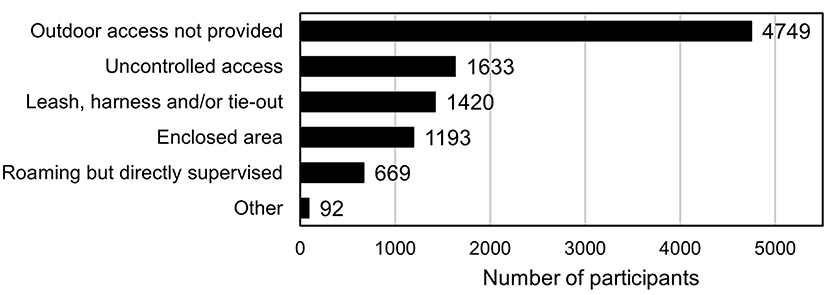
Figure 1. Owner-reported provision of outdoor access for companion cats, including method of provision (N = 7,838).
Cat management factors that have the potential to influence cat welfare when cats are allowed outside or kept solely indoors are summarized and presented in Tables 1, 2. Fewer cats with uncontrolled outdoor access were declawed and more were provided with collars or belled collars compared to cats without uncontrolled outdoor access (controlled or indoor). Indoor cats had more access to enrichment, such as interactive toys, elevated platforms, scratching areas, and exploratory items. Similar percentages were detected in regard to being licensed (21.8%, 25.7%) and neutered (97.2%, 97.9%) between cats with uncontrolled and controlled outdoor access.
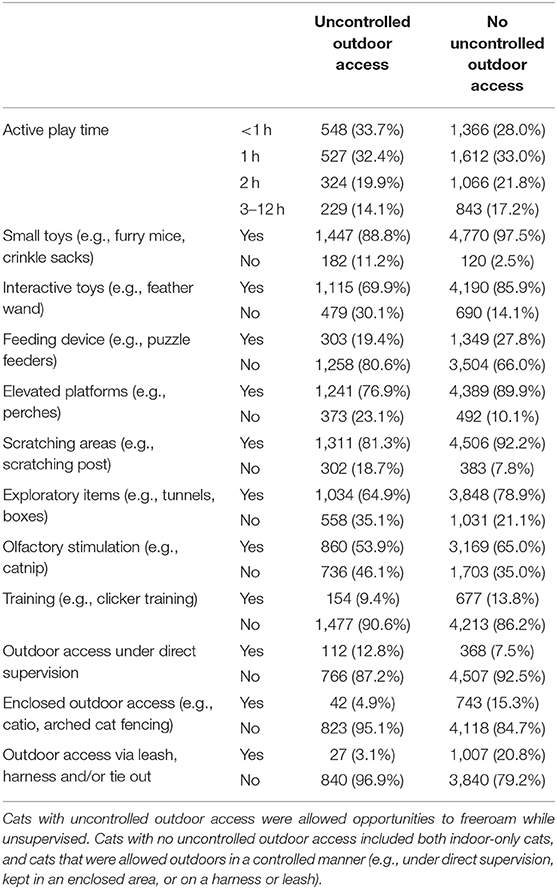
Table 1. Summary statistics for owner-reported provision of enrichment opportunities for cats with (n = 1,633) and without (n = 4,896) uncontrolled outdoor access.
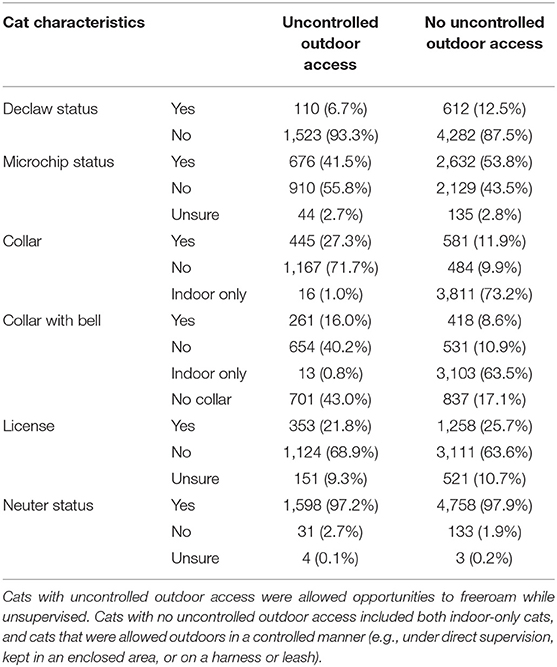
Table 2. Summary statistics for owner-reported characteristics of cat management that have the potential to impact the welfare of cats during outdoor access for cats with (n = 1,633) and without (n = 4,896) uncontrolled outdoor access.
Risk Factors
Risk factors of uncontrolled outdoor access are presented in Tables 3–7, and the final model included factors related to cat characteristics, the home environment, owner perspectives on outdoor access, and owner demographics.
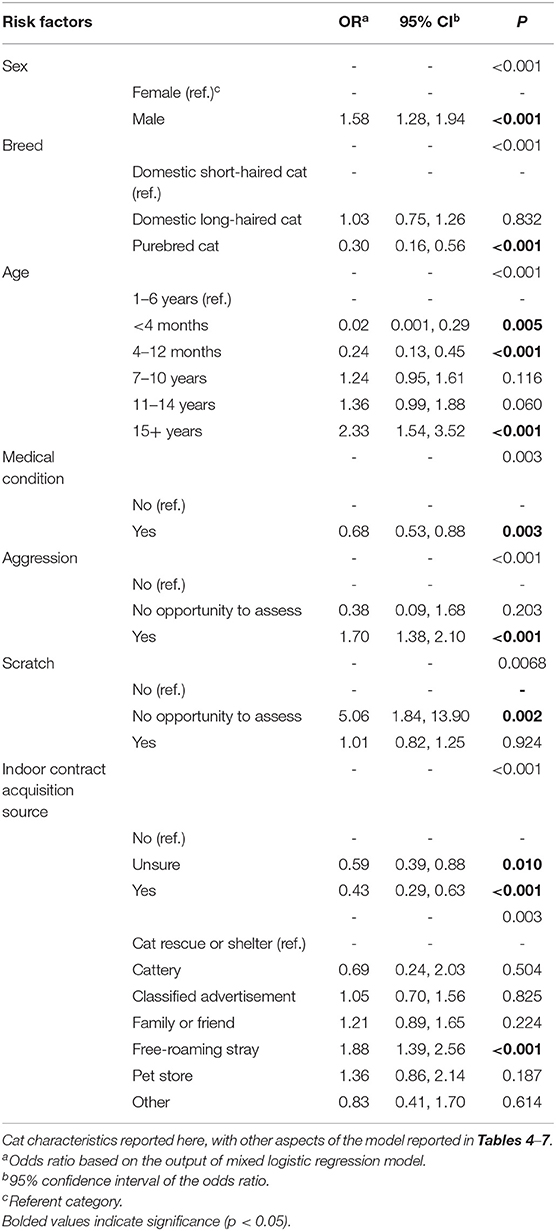
Table 3. Logistic regression model for risk factors associated with uncontrolled outdoor access for cats based on owner reports, with province/state asLiving location a random effect (N = 7,838 participants).
Cat Characteristic Factors
Male cats and cats older than 15 years of age had higher odds of being allowed uncontrolled outdoor access (Table 3). Cats who had aggressive behavioral issues directed toward people or other animals in and out of the household, also had increased odds of uncontrolled outdoor access. In contrast, cats who were less than a year old, were purebred, or had an existing medical condition, had decreased odds of being provided with uncontrolled outdoor access. If the owner reported that they had signed an indoor contract upon acquiring the cat, there was lower odds of the owner providing uncontrolled outdoor access.
Owner Demographic Factors
Owners who lived in a village (with a population of less than a thousand people) or resided on a farm had significantly higher odds of allowing their cat uncontrolled outdoor access (Table 4). In contrast, owners living in an apartment, condominium, townhouse, or semi-detached house had lower odds of giving their cats uncontrolled outdoor access. Women and owners who had a professional degree (e.g., veterinarian) also had lower odds of providing uncontrolled outdoor access to their cats.
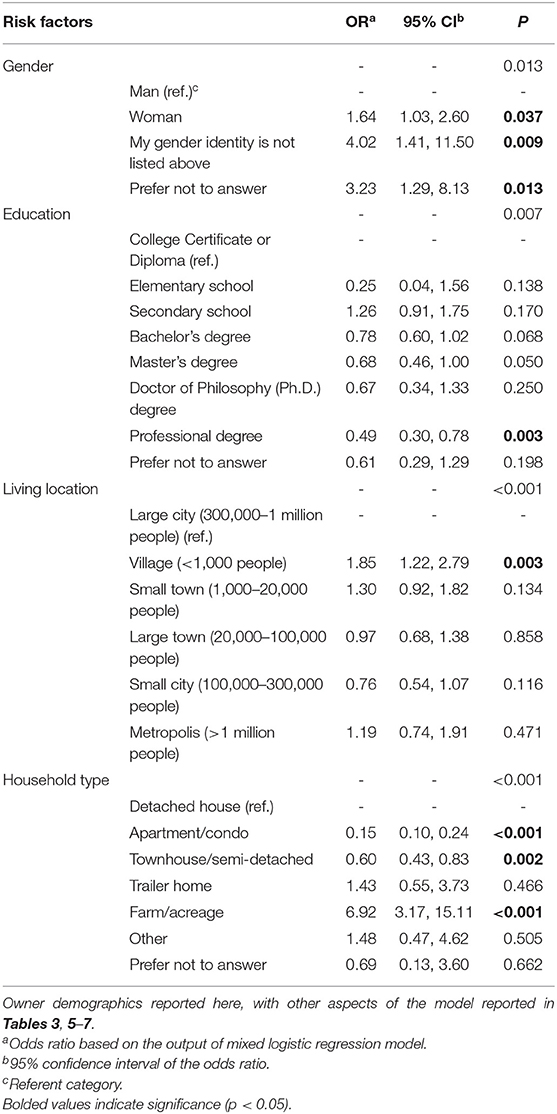
Table 4. Logistic regression model for risk factors associated with uncontrolled outdoor access for cats based on owner reports, with province/state as a random effect (N = 7,838 participants).
Owner Perspectives
Owners showed a range of perspectives on the benefits and risks associated with outdoor access (Figure 2). In general, owners who agreed with risks associated with outdoor access (e.g., contracting a disease) had lower odds of allowing uncontrolled outdoor access, and those who agreed with benefits of providing outdoor access (e.g., increased activity) had higher odds of letting their cats outside uncontrolled (Tables 5, 6).
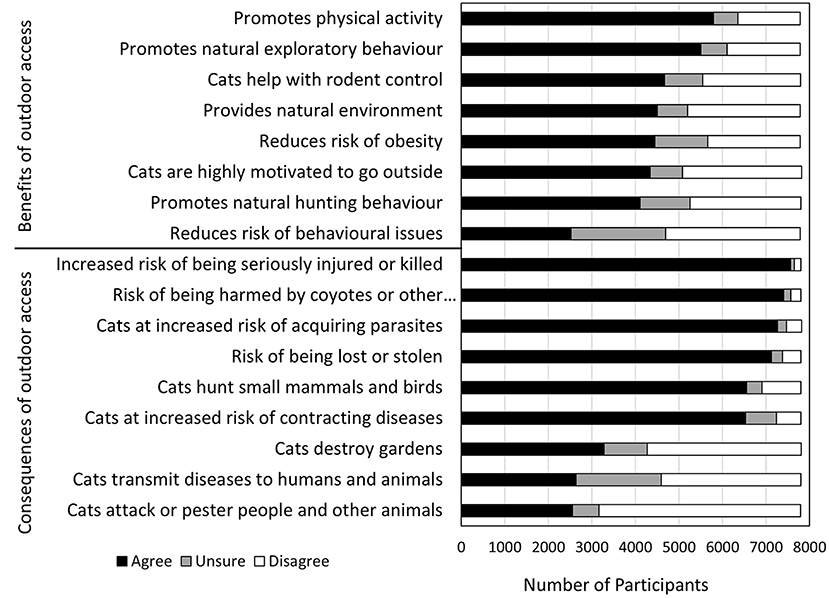
Figure 2. Owner responses on level of agreement with statements on the benefits and consequences of outdoor access for companion cats (N = 7,838).
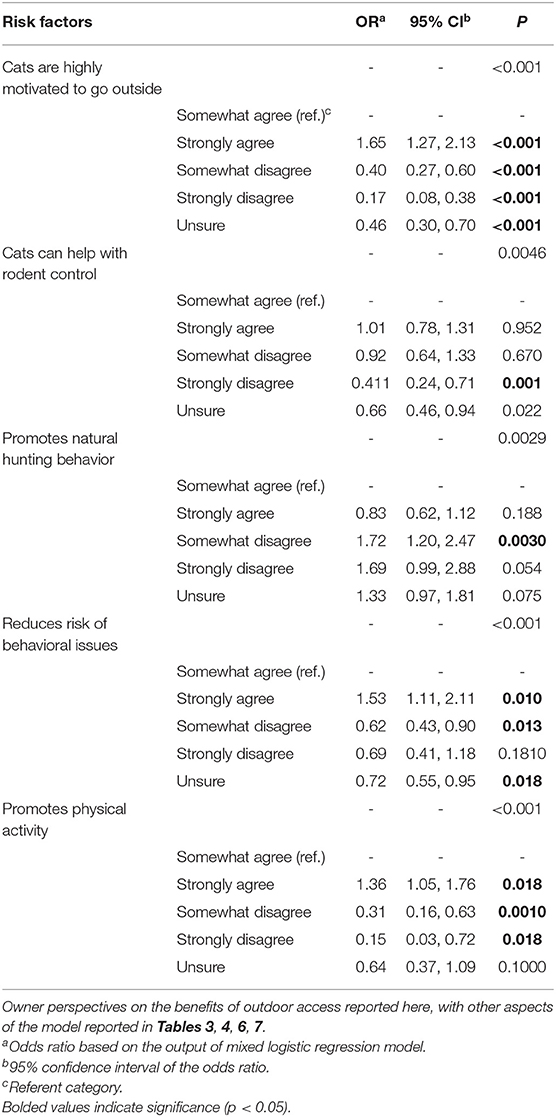
Table 5. Logistic regression model for risk factors associated with uncontrolled outdoor access for cats based on owner reports, with province/state as a random effect (N = 7,838 participants).
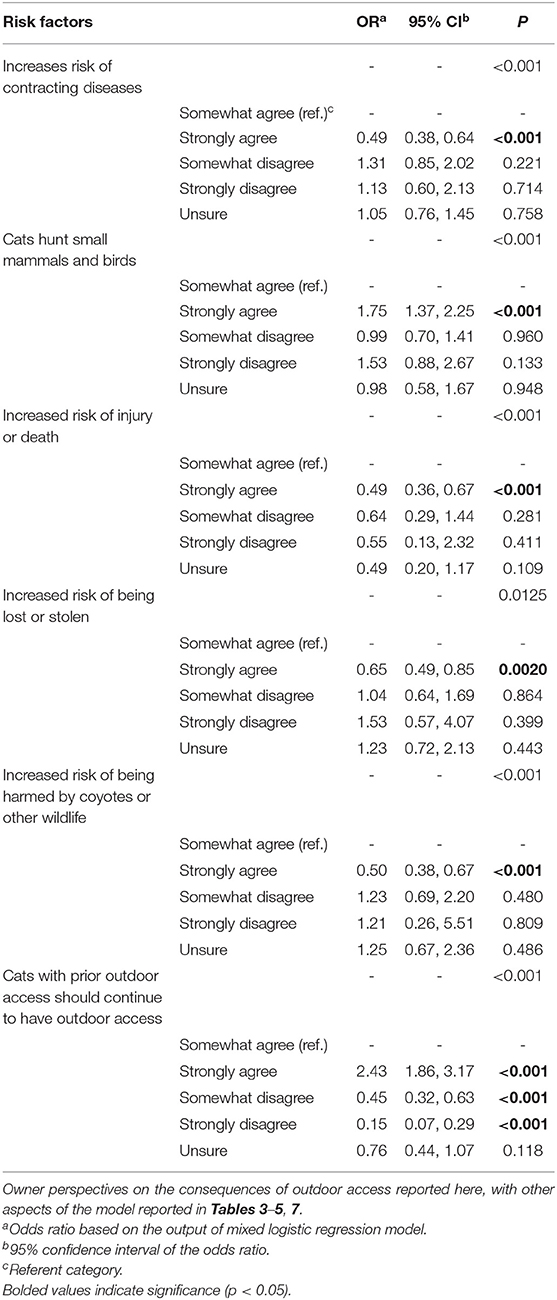
Table 6. Logistic regression model for risk factors associated with uncontrolled outdoor access for cats based on owner reports, with province/state as a random effect (N = 7,838 participants).
Home Environment and Enrichment Factors
Cat owners who had additional pets (e.g., dogs, fish, reptiles, and birds) in the home, had higher odds of providing uncontrolled outdoor access (Table 7). However, if owners provided interactive enrichment, such as feather wands, small toys, exploratory devices, and elevated platforms, the odds of the owner allowing uncontrolled outdoor access were lower.
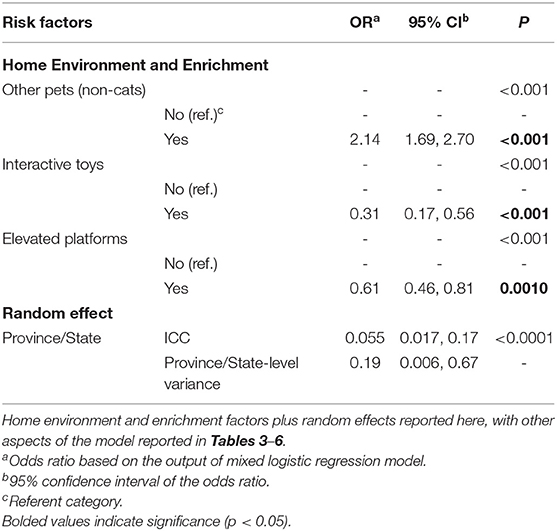
Table 7. Linear regression model for risk factors associated with uncontrolled outdoor access for cats based on owner reports, with province/state as a random effect (N = 7,838 participants).
Interactions
Significant interactions were found between the: cat's acquisition source and owner's agreement that outdoor access is beneficial for rodent control; cat's age and owner's agreement that cats are highly motivated to go outside; and owner's gender and agreement that outdoor access promotes physical activity. After reviewing the tested interactions, it was determined that the significant interactions involving owner perspectives were not meaningful. As a result, the interactions were not included in the final model, allowing for a more intuitive and parsimonious model. No biologically plausible confounders were identified for further assessment. Country was not a significant random effect and was thus excluded. The random effect, province/state, was significant, and based on the ICCs (95% CI) of the model, cats within the same province/state have a correlation of 0.055 (0.017, 0.17) (Table 7).
Discussion
Despite recent educational messages from animal welfare and conservation organizations in Canada and the US, results from the current study suggest that a large proportion of cat owners are providing uncontrolled outdoor access to their cats. While the majority of owners believed that cats with no prior outdoor experience should be kept indoors, there were still 1,119 owners (14.3%) who disagreed. This suggests that outdoor access does not depend on prior access experience as close to 21% of owners would still offer access to a new, inexperienced cat. There are also many owners allowing controlled outdoor access by having their cat on a leash, harness or tie-out, offering a catio or an enclosed area with cat-specific fencing, or letting the cats roam but only under direct supervision.
For cats who were allowed uncontrolled outdoor access, the majority of owners neutered their animals, which is important for reducing cat overpopulation and preventing hormonally mediated roaming. While 93% of outdoor cats had their claws, 7% of the uncontrolled outdoor cats were declawed, which is concerning as these animals are likely to be unable to defend themselves against predation. Few owners in this sample took measures to reduce potential cat loss through identification via microchip or collar or through licensing. One previous study found that a majority of cat owners agreed that microchipping helps lost cats reunite with their owners, but did not agree with cat licensing (19). This study did not assess the actual practices of these owners around microchipping and licensing, but another recent study from Australia found that 72% of cat owners reported microchipping their cat, which is much higher than what was found for the current study (36). Permanent identification (e.g., via microchip or tattoo) or provision of identification on a collar are commonly recommended to ensure the cat and owner can be identified and reunited if the cat is injured or becomes lost while outdoors (37).
Cat Characteristic Factors
The current results suggest that male cats are more likely to be provided uncontrolled outdoor access than female cats, which corresponds to the findings of another recent study with international scope (24). In a previous US study on outdoor access, access did not differ between female and male cats (23), but the sample size in that study was relatively small. It has been suggested that female cats might be more suited to live solely indoors compared to male cats based on differences in home range sizes. Mertens and Schär (38) observed that indoor, neutered males had a home range of 4–5 rooms, compared to 3–3.6 rooms for neutered females. As a result, male cats might be more motivated to roam than females, potentially leading to frustration and behavioral issues when restricted. However, the home range differences are relatively small and differences in motivation to roam have not been assessed in neutered male and female cats. Alternatively, owners might be more worried about female cats having uncontrolled outdoor access because of the potential for pregnancy. However, in the current study, 97% of the cats were neutered or spayed, so this hypothesis is unlikely to be a primary contributor to the provisioning of outdoor access.
Cat aggression toward people or other animals was also a factor associated with increased likelihood of outdoor access. However, the directionality of the relationship between aggression and outdoor access is unknown; cats might be let outside because of aggressive behavior, or cats might become aggressive due to the outdoor access provided. Levine et al. (39) observed that households with at least one cat with outdoor access experienced more inter-cat aggression than when all cats were kept indoors. They hypothesized that either cats with outdoor access bring new smells into the home creating aggression in the indoor cat(s), or inter-cat aggression results from redirected frustration from not receiving outdoor access (39).
In addition, cats older than 15 years had higher odds of outdoor access and cats younger than a year of age had lower odds. Foreman-Worsley et al. (24) also found that juvenile cats under 2 years of age were more likely to be kept indoors. It is possible that older cats have a higher probability of having previous outdoor access based on recently updated recommendations for keeping cats indoors, as owners reported strong agreement with continuing to provide outdoor access for cats with prior experience. In contrast, younger cats may be kept inside because they are not large enough to protect themselves or because they are not fully vaccinated or spayed/neutered [procedures typically done before 6 months of age (40)]; unvaccinated cats, particularly those younger than 4 months of age, would be more susceptible to contracting diseases, parasites, or illness, and unneutered young cats that are past sexual maturity would be capable of reproduction.
Similar to the results of Foreman-Worsley et al. (24), the current study found that cats who have an existing medical problem were less likely to have uncontrolled outdoor access. Cats with existing medical issues might be more susceptible to acquiring a disease or infection and/or vulnerability to predation. For example, particular diseases that are immunosuppressive and increase the risk of contracting secondary infections (41), such as Feline Leukemia Virus, might result in owners being less likely to allow their cat outdoors. Additionally, some medical issues (e.g., cancer and diabetes) require supportive care, such as assisted feeding and scheduled medication delivery (42), which could deter owners from allowing uncontrolled outdoor access as returning times could be unpredictable.
At many humane societies and animal shelters, adopters are required to sign contracts that ensure cats remain solely indoors, and our results suggest these contracts are effective at reducing the provision of uncontrolled outdoor access. It is possible that owners who acquired their cats from shelters are more educated about the potential consequences associated with outdoor access through educational materials provided by the shelter or breeder, and thus may be less likely to provide uncontrolled access. A similar relationship was discussed by Clancy et al. (23), who found a significant difference in provision of outdoor access between cats that were initially acquired from a shelter vs. as a stray, suggesting the prevention of uncontrolled outdoor access was due to the education provided by the shelters. However, some owners who had signed contracts were still providing uncontrolled outdoor access, suggesting that these contracts are not fully effective.
Owner Demographic Factors
The types of dwellings and areas that cat owners reside in influenced whether cats are allowed outside, with more uncontrolled outdoor access provided for cats in rural areas in comparison to urban areas; these results correspond with another study that found indoor restriction is associated with city centers and urban areas (24). Owners in urban areas have a greater likelihood of living in an apartment or housing with multiple floors that lack direct outdoor access compared to living in rural areas. Higher outdoor access in rural and farm areas might also relate to cats being kept as domestic predators to control pests (43), as confirmed by some participants in this study, who specifically stated in their comments that they owned cats for this purpose. Also, free-roaming cats have a higher likelihood of being involved in road traffic accidents in areas with heavy traffic, like urban or metropolitan cities, compared to rural areas. These accidents could cause serious injuries (e.g., rupturing internal organs or broken bones) that may result in financial or welfare ramifications (e.g., amputations) or death (16), and may deter owners from allowing outdoor access in high-traffic areas.
Women were less likely to allow uncontrolled outdoor access than men. Studies have shown that women tend to display more positive behaviors and concerns toward animal welfare and animal rights than men (44, 45). Research also suggests female pet owners have a stronger bond with their animals than male owners and this factor increased the likelihood of bringing their pets to the veterinarian for care (46). Furthermore, women have been found to interact with their cats (i.e., physically and verbally) more often than men, supporting the suggestion that women develop higher quality relationships with their cats (47). If women have stronger bonds with their cats, they may be more concerned about the risks associated with outdoor access. Owners with professional degrees (e.g., veterinarians or doctors) also had reduced odds of providing uncontrolled outdoor access, which might be attributable to greater awareness about the risks about this form of outdoor access (e.g., contractible diseases) and about general recommendations for pet care.
Owner Perspectives Factors
The majority of owner perspectives aligned as predicted, where owners who were concerned about risks to their cat's welfare (e.g., being injured or contracting a disease) had lower odds of providing uncontrolled outdoor access, and owners who agreed with factors related to outdoor access that could enhance their cat's welfare (e.g., reduce risk of behavioral issues) had higher odds of providing uncontrolled outdoor access. These findings are similar to those of another owner-completed survey that found that owners cited various outdoor risks as reasons for keeping their cats indoors (24). Our findings are further supported by previous research with Australian cat owners. One study found that a major barrier to containment was a belief that cats need to wander for mental and physical health (27), and another study found that owners that keep their cats indoors are more likely to believe confinement protects cats from injury (25).
However, not all perspectives aligned. For example, owners who agreed that “outdoor access for cats is problematic because cats hunt small mammals and birds” had higher odds of providing outdoor access. Similarly, other studies have found that beliefs about cats influencing wildlife are either not or only weakly correlated with cat owner behaviors and intentions around keeping cats indoors (26, 27). This misalignment could be due to cognitive dissonance, which is a result of conflict between attitudes and behaviors (48). According to Akpan et al. (49), people's actions do not always align with their beliefs, which could explain how even though owners are aware of the associated risks with outdoor access, they continue to provide access. Alternatively, some owners might have had positive feelings about pest control by cats. For example, Foreman-Worsley et al. (24) found that some owners relied on cats for control of rats and mice on their property. We might have found different results in the current study had we separated reporting for species thought of as pests from songbirds and other “attractive” wildlife. Additionally, there were owners who were not aware of certain risks. For example, only 33.8% of owners agreed that outdoor cats can transmit diseases to humans and animals; however, as Kasbaoui (9) demonstrated, contact with wildlife and other animals can increase transmission of diseases and parasites to cats, and also to other animals via cats. Even when certain risks are widely recognized, owners are still providing uncontrolled access, suggesting a disconnect between knowledge and action. Interestingly, one recent intervention study found that wildlife protection messaging was effective at increasing both motivation to contain and belief that containing was possible in a sample of Australian cat owners, suggesting that further education could be effective for altering cat containment activities (29).
Enrichment and Home Environment Factors
Other pets living in the cat's home environment increased the odds of having outdoor access. This corresponds to the results of Foreman-Worsley et al. (24) which found that owners cited having a multi-cat household as one of the reasons why they allow their cat outdoor access; open-text responses from owners in this study suggested outside access provided additional space for the cats to get away from each other. Without a safe place to allow escape from unfamiliar or undesired situations (8) the likelihood of having inter-animal aggression or problems between pets is greater. Further research is necessary to explore this relationship.
The provision of interactive enrichment in the home reduced the odds of cats being given uncontrolled outdoor access. This relationship is likely not causal; instead, owners who keep their cats indoors are probably more likely to provide enhanced enrichment to account for the limited and confining indoor environment. The current study found that cats without uncontrolled outdoor access were provided with more enrichment types (e.g., small toys, interactive toys, and scratching areas) than cats with uncontrolled access. Enrichment promotes species-specific behavior, such as chasing, climbing, or biting by imitating prey or natural environments (8). For animals without outdoor access, their indoor environment may be enhanced with enrichment, minimizing boredom and behavioral issues, such as aggression (15). Therefore, while indoor housing can limit physical activity and the ability to perform natural behaviors, providing interactive enrichment can improve their housing quality and promote their well-being.
Limitations
The majority of the participants reported that they resided in Canada, and most of them resided in Ontario. Furthermore, as is common for online surveys (50), this survey also had more women respondents than men. Due to the disproportionate gender ratio and number of participants from particular regions, it is possible that findings and trends may not generalize broadly to the target population. However, the sample size was relatively large, with reasonable representation from males and different geographical areas. In addition, the regression model accounted for gender through inclusion in analysis as well as geographical clustering through inclusion of participant state/province as a random effect, and while significant, the effect size for state/province was small and significance was likely a result of the large sample size. Additionally, since this survey relied on owner self-reporting, social desirability bias, a bias involving answering based on what is believed to be favorable or are society's norms, may have occurred. Accompanied with owners being unable to accurately recall details, such as average time spent outside, the results of how owners care for their cats and perceive cat welfare may have been skewed.
Since the survey was cross-sectional, capturing prevalence data at one period in time, it is not possible to infer causation or illustrate longitudinal trends. Also, because this was an exploratory and hypothesis-generating study, the high number of variables tested increased the chance of type one errors. The cross-sectional and exploratory nature of this current study, however, highlights areas for future research through controlled studies.
Conclusions
One fifth of owners in the current survey allowed their cats with uncontrolled outdoor access, and many owners that provided outdoor access failed to implement management strategies that are commonly recommended to protect the welfare of cats and of wildlife, such as microchipping and using a collar with a bell. Several factors that were associated with the provision of uncontrolled outdoor access were identified, including factors related to cat characteristics (e.g., sex, breed, cat age, existing medical conditions, aggression), the home environment (e.g., other animals in the home), owner perspectives (e.g., benefits and risks associated with outdoor access), and owner demographics (e.g., gender, level of education, location, and type of household). The majority of owners were aware of the primary risks and benefits associated with outdoor access, but their attitudes were not the sole factor that influenced the provision of outdoor access. Based on the current results, further research is needed to explore domestic cat needs and the other outdoor alternatives to promote and protect the welfare of owned domestic cats. Outdoor access is a multifactorial decision and future research should explore the impact of outdoor access on cat welfare, the effect of owner-pet bonds on outdoor access and the efficacy of educational programs on owner perspectives toward outdoor access.
Data Availability Statement
The datasets presented in this article are not readily available because consent was not provided for distribution during ethical approval. However, particular details can be provided upon request. Requests to access the datasets should be directed to Lee Niel at bmllbGxAdW9ndWVscGguY2E=.
Ethics Statement
The studies involving human participants were reviewed and approved by University of Guelph Research Ethics Board-Natural, Physical and Engineering Sciences and The University of British Columbia Behavioral Research Ethics Board. The patients/participants provided their written informed consent to participate in this study.
Author Contributions
ST and AS organized the database and performed the statistical analysis. ST wrote the first draft of the manuscript. All authors contributed to conception, design of the study, contributed to manuscript revision, read, and approved the submitted version.
Funding
Publications fees for this article were provided by the Ontario Veterinary College Pet Trust Fund.
Conflict of Interest
The authors declare that the research was conducted in the absence of any commercial or financial relationships that could be construed as a potential conflict of interest.
Publisher's Note
All claims expressed in this article are solely those of the authors and do not necessarily represent those of their affiliated organizations, or those of the publisher, the editors and the reviewers. Any product that may be evaluated in this article, or claim that may be made by its manufacturer, is not guaranteed or endorsed by the publisher.
References
1. Canadian Federation of Humane Societies (CFHS). A Five-Year Review of Cat Overpopulation. Ottawa: CFHS (2017). Available online at: https://humanecanada.ca/wp-content/uploads/2020/03/Cats_In_Canada_ENGLISH.pdf (accessed: July 15, 2021).
2. The Humane Society of the United States (HSUS). Washington: HSUS; Pets by the numbers (2019). Available online at: https://www.animalsheltering.org/page/pets-by-the-numbers (accessed: July 8, 2019).
3. The British Columbia Society for the Prevention of Cruelty to Animals (BC SPCA). Vancouver: BC SPCA. Position Statement on Cat Welfare. (2019). Available online at: https://spca.bc.ca/programs-services/leaders-in-our-field/position-statements/position-statement-on-cat-welfare/ (accessed: July 8, 2019).
4. American Society for the Prevention of Cruelty to Animals (ASPCA). General Cat Care. New York: ASPCA (2019). Available online at: https://www.aspca.org/pet-care/cat-care/general-cat-care (accessed: July 8, 2019)
5. Cats and Birds. Nature Canada. (2019). Available online at: https://catsandbirds.ca/about/ (accessed: July 8, 2019).
6. American Bird Conservancy. The Plains: American Bird Conservancy. Cats and other invasives (2019). Available online at: https://abcbirds.org/threat/cats-and-other-invasives/ (accessed: July 8, 2019).
7. Rochlitz I. The effects of road traffic accidents on domestic cats and their owners. Anim Welf. (2004) 13:51–5. Available online at: https://www.ingentaconnect.com/contentone/ufaw/aw/2004/00000013/00000001/art00008
8. Ellis SLH, Rodan I, Carney HC, Heath S, Rochlitz I, Shearburn LD, et al. AAFP and ISFM feline environmental needs guidelines. J Feline Med Surg. (2013) 15:219–30. doi: 10.1177/1098612X13477537
9. Kasbaoui N. Risk and Benefits to Cats of Free Roaming Versus Containment. [Ph.D. Dissertation]: The University of Lincoln (2016).
10. Rowe E, Browne W, Casey R, Gruffydd-Jones T, Murray J. Risk factors identified for owner-reported feline obesity at around one year of age: dry diet and indoor lifestyle. Prev Vet Med. (2015) 121:273–81. doi: 10.1016/j.prevetmed.2015.07.011
11. Amat M, Ruiz de la Torre JL, Fatjã J, Mzariotti VM, Wijk SV, Manteca X. Potential risk factors associated with feline behaviour problems. Appl Anim Behav Sci. (2009) 121:134–9. doi: 10.1016/j.applanim.2009.09.012
12. Heidenberger E. Housing conditions and behavioural problems of indoor cats as assessed by their owners. Appl Anim Behav Sci. (1997) 52:345–64. doi: 10.1016/S0168-1591(96)01134-3
13. Pryor PA, Hart BL, Bain MJ, Cliff KD. Causes of urine marking in cats and effects of environmental management on frequency of marking. J Am Vet Med Assoc. (2001) 219:1709–13. doi: 10.2460/javma.2001.219.1709
14. Sandøe P, Nørspang AP, Forkman B, Bjornvad CR. The burden of domestication: a representative study of welfare in privately owned cats in Denmark. Anim Welf. (2017) 26:1–10. doi: 10.7120/09627286.26.1.001
15. Strickler BL, Shull EA. An owner survey of toys, activities, and behaviour problems in indoor cats. J Vet Behav. (2014) 9:207–14. doi: 10.1016/j.jveb.2014.06.005
16. Olsen TF, Allen AL. Causes of sudden and unexpected death in cats: a 10-year retrospective study. Can Vet J. (2001) 42:61–2.
17. Fitzgerald KT. Lily toxicity in the cat. Top Companion Anim Med. (2010) 25:213–7. doi: 10.1053/j.tcam.2010.09.006
18. Van Patter L, Flockhart T, Coe J, Berke O, Goller R, Hovorka A, et al. Perceptions of community cats and preferences for their management in Guelph, Ontario. Part 1: quantitative analysis. Can Vet J. (2019) 60:41–7.
19. Dabritz HA, Atwill ER, Gardner IA, Miller MA, Conrad PA. Outdoor fecal deposition by free-roaming cats and attitudes of cat owners and nonowners toward stray pets, wildlife, water pollution. J Am Vet Med Assoc. (2006) 229:74–81. doi: 10.2460/javma.229.1.74
20. Loss SR, Will T, Marra PP. The impact of free-ranging domestic cats on wildlife of the United States. Nat Commun. (2013) 4:1396. doi: 10.1038/ncomms2380
21. Lynn WS, Santiago-Avila F, Lindenmayer J, Hadidian J, Wallach A, King BJ. A moral panic over cats. Conserv Biol. (2019) 33:769–76. doi: 10.1111/cobi.13346
22. Trouwborst A, McCormack PC, Camacho EM. Domestic cats and their impacts on biodiversity: a blind spot in the application of nature conservation law. People Nat. (2020) 2:235–50. doi: 10.1002/pan3.10073
23. Clancy EA, Moore AS, Bertone ER. Evaluation of cat and owner characteristics and their relationships to outdoor access of owned cats. J Am Vet Med Assoc. (2003) 222:1541–5. doi: 10.2460/javma.2003.222.1541
24. Foreman-Worsley R, Finka LR, Ward SJ, Farnworth MJ. Indoors or outdoors? An international exploration of owner demographics and decision making associated with lifestyle of pet cats. Animals. (2021) 11:253. doi: 10.3390/ani11020253
25. Toukhsati SR, Young E, Bennett PC, Coleman GJ. Wandering cats: attitudes and behaviors towards cat containment in Australia. Anthrozoos. (2012) 25:61–74. doi: 10.2752/175303712X13240472427195
26. van Eeden LM, Hames F, Faulkner R, Geschke A, Squires ZE, McLeod EM. Putting the cat before the wildlife: exploring cat owners' beliefs about cat containment as predictors of owner behavior. Conserv Sci Pract. (2021) 3:e502. doi: 10.1111/csp2.502
27. MacDonald E, Milfont T, Gavin M. What drives cat-owner behaviour? First steps towards limiting domestic-cat impacts on native wildlife. Wildl Res. (2015) 42:257–65. doi: 10.1071/WR14164
28. McLeod LJ, Hine DW, Bengsen AJ. Born to roam? Surveying cat owners in Tasmania, Australia, to identify the drivers and barriers to cat containment. Prev Vet Med. (2015) 122:339–44. doi: 10.1016/j.prevetmed.2015.11.007
29. McLeod LJ, Hine DW, Bengsen AJ, Driver AB. Assessing the impact of different persuasive messages on the intentions and behaviour of cat owners: a randomized control trial. Prev Vet Med. (2017) 146:136–42. doi: 10.1016/j.prevetmed.2017.08.005
30. Sadler GR, Lee HC, Lim RSH, Fullerton J. Research article: recruitment of hard-to-reach population subgroups via adaptations of the snowball sampling strategy. Nurs Health Sci. (2010) 12:369–74. doi: 10.1111/j.1442-2018.2010.00541.x
31. Biernacki P, Waldorf D. Snowball sampling: problems and techniques of chain referral sampling. Sociol Methods Res. (1981) 10:141–63. doi: 10.1177/004912418101000205
32. Stella JL, Croney CC. Environmental aspects of domestic cat care and management: implications for cat welfare. Sci World J. (2016) 2016 :6296315. doi: 10.1155/2016/6296315
33. Dohoo I, Martin W, Stryhn H. Veterinary Epidemiological Research. 2nd Edn. Charlottetown: VER Inc (2003).
34. Vogt AM, Rodan I, Brown M, Brown S, Buffington CAT, Forman MJL, et al. AAFP-AAHA feline life stage guidelines. J Am Anim Hosp Assoc. (2010) 46:70–85. doi: 10.5326/0460070
35. Ferguson E, Cox T. Exploratory factor analysis: a users' guide. Int J Sel Assess. (1998) 1:84–94. doi: 10.1111/j.1468-2389.1993.tb00092.x
36. Elliot A, Howell TJ, McLeod EM, Bennett PC. Perceptions of responsible cat ownership behaviors among a convenience sample of Australians. Animals. (2019) 9:703. doi: 10.3390/ani9090703
37. Lord LK, Griffin B, Slater MR, Levy JK. Evaluation of collars and microchips for visual and permanent identification of pet cats. J Am Vet Med Assoc. (2010) 237:387–94. doi: 10.2460/javma.237.4.387
38. Mertens C, Schär R. Practical aspects of research on cats. In: Turner DC, Bateson P, editors. The Domestic Cat: The Biology of its Behaviour. 1st Edn. Cambridge: Cambridge University Press (1988). p. 179–90.
39. Levine E, Perry P, Scarlett J, Houpt KA. Intercat aggression in households following the introduction of a new cat. Appl Anim Behav Sci. (2005) 90:325–36. doi: 10.1016/j.applanim.2004.07.006
40. Ontario Veterinary Medical Association. Milton: Ontario Veterinary Medical Association. Pet health 101 (2019). Available online at: https://www.ovma.org/pet-owners/basic-pet-care/pet-health-101/ (accessed: July 8, 2019).
41. Levy JK, Scott HM, Lachtara JL, Crawford PC. Seroprevalence of feline leukemia virus and feline immunodeficiency virus infection among cats in North America and risk factors for seropositivity. J Am Vet Med Assoc. (2006) 228:371–6. doi: 10.2460/javma.228.3.371
42. Little S, Peterson ME. Special-needs cats-cats with cancer and diabetic cats with chronic kidney disease. In: Proceedings of The Royal Canine Feline Symposium, USA (2013).
43. Mahlaba TAM, Monadjem A, McCleery R, Belmain SR. Domestic cats and dogs create a landscape of fear for pest rodents around rural homesteads. PLoS ONE. (2017) 12:e0171593. doi: 10.1371/journal.pone.0171593
44. Herzog HA. Gender differences in human-animal interactions: a review. Anthrozoos. (2007) 20:7–21. doi: 10.2752/089279307780216687
45. Phillips C, Izmirli S, Aldavood J, Alonso M, Choe B, Hanlon A, et al. An international comparison of female and male students' attitudes to the use of animals. Animals. (2011) 1:7–26. doi: 10.3390/ani1010007
46. Lue TW, Pantenburg DP, Crawford PM. Impact of the owner-pet and client-veterinarian bond on the care that pets receive. J Am Vet Med Assoc. (2008) 232:531–40. doi: 10.2460/javma.232.4.531
47. Turner DC. The mechanics of social interactions between cats and their owners. Front Vet Sci. (2021) 8:650143. doi: 10.3389/fvets.2021.650143
49. Akpan J, Beard L, Notar CE. Cognitive dissonance: the bane of value systems. Int J Educ Vocat Guid. (2018) 3:1–5. Available online at: http://www.ijssb.com/images/vol3.no.1/1.pdf
Keywords: Felis catus, outdoor access, perspectives, animal welfare, owner, cat
Citation: Tan SML, Jajou S, Stellato AC and Niel L (2021) Perspectives of Canadian and American Cat Owners on Provision of Uncontrolled Outdoor Access for Owned Domestic Cats. Front. Vet. Sci. 8:742245. doi: 10.3389/fvets.2021.742245
Received: 15 July 2021; Accepted: 28 September 2021;
Published: 26 October 2021.
Edited by:
Lynette Arnason Hart, University of California, Davis, United StatesReviewed by:
Dennis Clair Turner, Institute for Applied Ethology and Animal Psychology, SwitzerlandDara M. Wald, Iowa State University, United States
Copyright © 2021 Tan, Jajou, Stellato and Niel. This is an open-access article distributed under the terms of the Creative Commons Attribution License (CC BY). The use, distribution or reproduction in other forums is permitted, provided the original author(s) and the copyright owner(s) are credited and that the original publication in this journal is cited, in accordance with accepted academic practice. No use, distribution or reproduction is permitted which does not comply with these terms.
*Correspondence: Lee Niel, bmllbGxAdW9ndWVscGguY2E=
†Present address: Sarah M. L. Tan, College of Veterinary Medicine and Biomedical Sciences, Colorado State University, Fort Collins, CO, United States
Anastasia C. Stellato, Department of Animal and Food Sciences, Texas Tech University, Lubbock, TX, United States
 Sarah M. L. Tan
Sarah M. L. Tan Sarah Jajou
Sarah Jajou Anastasia C. Stellato
Anastasia C. Stellato Lee Niel
Lee Niel